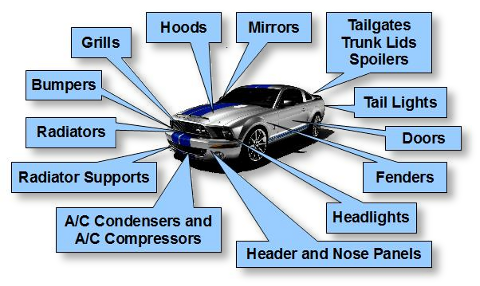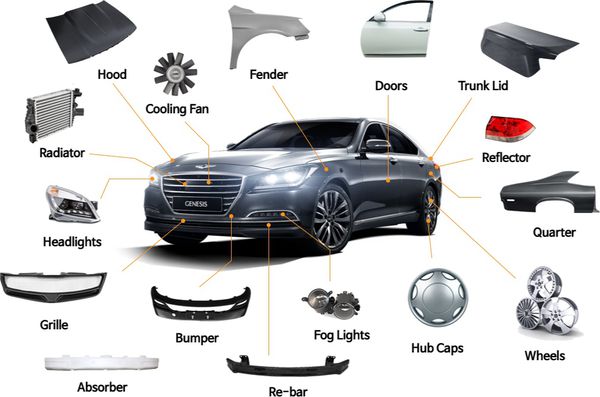20 Good Reasons For Deciding On Car Parts
20 Good Reasons For Deciding On Car Parts
Blog Article
Top 10 Tips To Consider About Quality And Source Of Car Parts
These are suggestions on how to evaluate the quality and authenticity of auto components. They will also provide their pros, cons and benefits.
1. Choose OEM vs. Aftermarket
Select OEM (Original Equipment Manufacturing) or aftermarket components.
Pros:
OEM parts are guaranteed to be perfect in fit and performance.
High-quality parts aftermarket can be affordable.
Cons:
OEM parts tend to be more expensive.
Aftermarket parts can be less durable in comparison to OEM parts.
2. Verify certifications and standards.
Tip Find parts that have been certified by SAE or ISO.
Pros : ensuring the safety of employees and ensuring compliance.
Cons: Parts that are certified may cost more and are hard to locate for older vehicles.
3. Find the Reputation of Manufacturers
Tip: Opt to buy well-known trusted brands.
Benefits: It decreases the possibility of parts of poor quality falling apart early.
Cons: Reputable brands could have copyright products in circulation, requiring extra vigilance.
4. Shop at Trusted Retailers
Purchase parts only from authorized dealers and reputable online platforms.
Benefits: Most reliable retailers offer guarantees on their goods and can check the quality.
Cons: Prices are higher than those of third-party vendors that haven't been confirmed.
5. The construction material and quality should be checked
Tips: Ensure that you have robust material, resistance to corrosion and proper construction.
Pros: It guarantees safety and long-lasting performance.
Cons: You may not have the opportunity to test the online parts purchased prior to making a purchase.
6. Take into consideration refurbished or remanufactured parts
Refurbished options are a great option for expensive components such as engines and transmissions.
Pros: Sourced from reputable suppliers, it's cost-effective and does not sacrifice quality.
Cons: Poor quality dependent on the process of refurbishing.
7. Beware of copyright Products
Check the part number the logo, part number, or packaging to avoid counterfeits.
Benefits: Helps to prevent installing dangerous or unsuitable parts.
Pros: Identifying counterfeits is difficult and requires expertise.
8. Make sure you check for warranty
Tips: Prioritize the parts that have a warranty to cover defects or failures.
Pros offers peace of mind and financial protection.
Cons: Claims for warranty can take time to process if there are issues.
9. Check out customer reviews and ratings
TIP: Go through online reviews for insights on performance, durability, and fitting.
Pros: Helps to identify trustworthy products and also weed out inferior ones.
Cons: Some reviews can be biased or not reliable.
10. Find out about regional variations in terms of quality
Keep in mind that different regions could create parts with different quality (e.g. replica factories against. original factories).
Benefits: You'll receive the best possible quality for your market.
Cons: Imports high in quality can cost more or take longer.
Final Thoughts on Weighing both Pros and Con
Pros:
Safety, reliability and performance are all enhanced by using better quality parts.
A trusted supplier reduces the risk of defective parts warranties, copyright parts, and other problems.
Cons:
Certain parts are more expensive than other parts.
Verifying the authenticity and high quality of products requires extra effort.
Make smarter choices by taking into consideration quality and source. This will allow you to ensure the long-term performance of your car and its value. Take a look at the best pacelajs car parts par mercedes-benz cars for website recommendations including arto parts, bmw bits, parts by vin, ford's auto salvage, dar parts, volvo auto salvage, auto parts on pulaski, spare part auto, spare parts by vin, auto parts l and more.
Ten Tips To Install Car Parts
When buying auto parts, understanding installation specifications will help avoid unexpected failures or costs. The following are 10 important tips and their pros and con:
1. If a professional installation is required
TIP: Determine whether the component needs to be installed by a qualified mechanic, particularly for crucial components such as suspensions or brakes.
Pros: Ensures the correct installation and warranty protection.
Cons: Higher total costs because of labor charges.
2. Assess the complexity of installation
Find out more about the difficulty of installation (e.g. bolt-on or complex wiring).
Cons: You are able to decide whether you'd prefer to do it yourself or employ an expert.
Cons: Complex installations may cause errors if done without experience.
3. Make sure that you have access and availability of essential tools
Tips: Find out if any special tools are needed for the installation (e.g. torque wrenches or diagnostic equipment).
Benefits: Reduces the chance of delays and improper installations.
Cons: Purchasing specialized tools can add to costs.
Review the Instructions and Support In the Document
Tip: Verify that the item comes with clear instructions for installation, drawings and customer service.
It simplifies installation and reduces errors.
Cons: A lack of instructions can result in confusion or incorrect installations.
5. Verify Compatibility With Adjacent Parts
Tip: Make sure the new component works seamlessly with the other components.
Cons: Reduces risk of failure, and also saves time.
Cons: Buying additional components if you do not take note of this could be costly.
6. Calculate the Calibration Needs and Programming
Tips: Before installing any component, make sure to check whether it requires software or calibration updates (e.g. sensors or electronic modules).
Pros: It ensures optimal performance, and also prevents malfunctions.
Cons: Calibration may require specialized equipment or expertise.
7. Find out about the requirements for requirements for safety and environmental protection.
Be aware of any safety or environmental conditions prior to installation, such as the necessity of proper ventilation and safety gear.
Pros: It helps avoid accidents and ensure safe handling.
Cons A second or additional preparation might be required.
8. Make sure you have time to shut down during installation
Take note of the time it will take to set up the system, and if your vehicle is out of commission for a short period.
Pros Controls schedules and reduces the possibility of.
Cons: Lengthy installations can disrupt your daily routine.
9. Check Warranty Requirements for Installation
Tips: Determine whether the warranty on the component requires a skilled installer or a specific procedure.
Benefits: Warranty coverage remains in effect.
Cons: Installations that are not certified or incorrectly executed could make it impossible to honor the warranty.
10. Factors in Maintenance and Future Accessibility
Tip: Assess whether the location for installation permits easy access for future maintenance or replacement.
The ease of future repairs.
Cons: Installations that are not accessible can cause higher labor costs.
Last Thoughts: Weighing the Pros and Cons
Consider the following advantages of knowing the installation requirements:
Correctly installing the software will less likely to result in errors.
Cost management can be made simpler by determining the equipment and services are needed.
This ensures safety and maximum performance of the installed part.
Cons of Ignoring Installation Requirements
A mistake in installation can cause damage to your car or cause damage to parts.
Can result in invalidated warranties or additional costs.
Unanticipated complications may delay the return of the vehicle to normal service.
Be aware of these guidelines before deciding on the best way to put the piece in place. These will help you to make a well-informed choice and ensure it is installed correctly. Take a look at the most popular security parts for changfeng cars for more advice including spare parts vin, bmw auto wrecking, bmw auto parts near me, parts reviews, at auto parts, auto parts lv, a2z parts, parts code, parts bmw, auto k and more.